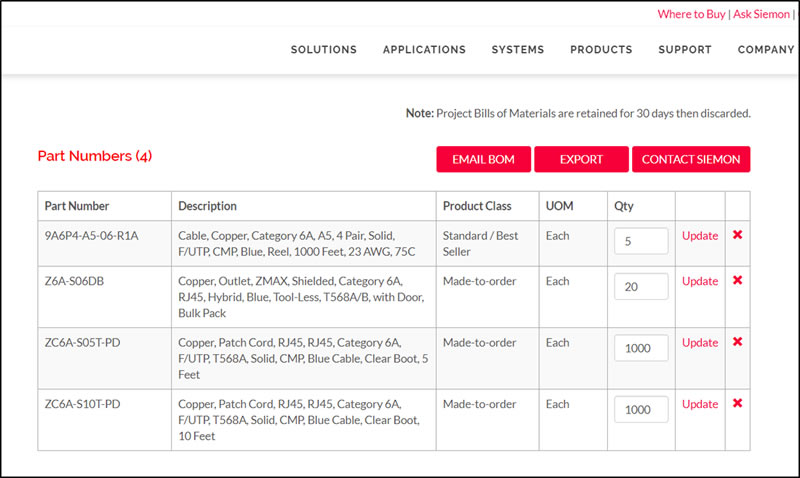5 Tips for an Effective BOM
Filed under: General
Comments: Comments Off on 5 Tips for an Effective BOM


Low-voltage cabling infrastructures are becoming more complex than ever. LANs have more connected devices in more locations and data centers are shifting to fully-meshed leaf-spine architectures where every switch is connected to every other switch via redundant pathways. With these complexities come a wider variety of copper and fiber cable and connectivity components and associated racks, cabinets and cable management needed to build reliable, high-performance networks-and that means more extensive and diverse project bills of material (BOMs).
When it comes to generating a BOM for a project bid proposal, inaccuracy and lack of detail is a surefire way to lose the bid opportunity or lead to unexpected costs and scheduling delays during the implementation stages if the bid is won. And if you’re putting together pricing for discretionary work with an existing customer, failure to include all the right parts and pieces will most definitely cost you time and money. We’ve put together the top 5 tips to make sure your BOMs have all the ingredients necessary for success.
1. Include the Right Amount of Detail
A general rule of thumb when it comes to creating a BOM is the more detail, the better. Don’t assume that your customer is going to recognize part numbers and acronyms. At the very least, your BOM should include part numbers, product name and description, manufacturer and quantities. Including additional information like intended application and location, dimensions, color, units of measurement and product resource links for customer use drawings, spec sheets and installation instructions can also be helpful.
2. Check and Double Check for Omissions
There are many ways that a network infrastructure project can go over budget but leaving components off your BOM should not be one of them. If you’re working off a fixed bid, the cost of omitting components can be passed on to you-and it can cause project delays that cost you even more and ultimately damage your reputation. And it’s not just components you need to worry about. Don’t forget all the labor costs, including time for testing and labeling of the network that can add up to thousands of dollars. Even not-so-obvious soft costs like temporary power, disposal fees and site prep should be included. Using a checklist as you prepare your BOM is a good idea, and make sure to go back and double check (or maybe even triple check). It also never hurts to have a second pair of eyes look over your BOM to make sure you didn’t miss anything.
3. Do Your Homework
Before finalizing your BOM, it’s best to work with your manufacturer and distributor to verify costs, availability and lead times. Verifying this information early during the planning phase can help avoid the extra time and cost involved in finding replacement products or introducing schedule delays. This is especially important for the components that have the highest monetary value and those required for the first stages of installation. While you might be able to wait for those special-order purple patch cords until later in a project, not verifying availability on the bulk cable needed for the job can delay the project start date (and your revenue). If there’s any flexibility in the project specs, you may even want to identify any alternative components ahead of time as a back-up plan.
4. Don’t Make Assumptions
Before you build your BOM, make sure the plans and spec are clear so that you know exactly what’s expected from both a material and labor standpoint. Check with the customer on any areas of a project spec that seem vague. If something looks “off” to you, it very well could be the spec that’s the problem. The last thing you want to do is leave off a critical line item because you “assumed” it wasn’t included in the spec even though your intuition and experience told you that it should be.
5. Use Siemon’s Automatic BOM Generation Tool
One of the biggest barriers to building an accurate BOM is using outdated manual processes. Thumbing through a paper catalog and typing part numbers into a spreadsheet is not only time-consuming-it’s also a sure way to end up with errors, especially considering that a single component can have literally thousands of part numbers due to a wide range of attributes like performance level, construction, jacket type, color, size, length, polarity and packaging.

Using an online BOM generation tool like the one offered with Siemon’s new e-catalog lets you avoid manual errors and execute BOMs faster and more accurately, which can ultimately expedite pricing and give you a leg up on the competition. Our intuitive online BOM generator lets you filter product attributes to get to the right part number, specify quantities and automatically add them to a specific project BOM that can be exported into a spreadsheet, complete with detailed product description, product class and units of measure. And because the BOM generator is linked with Siemon’s existing internal system, you can rest assured that your BOM will include the most up-to-date product information.
To quickly and easily build an accurate BOM for your next low-voltage infrastructure project, click HERE to access our new best-in-class eCatalog with BOM generator.
